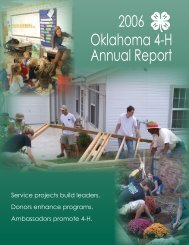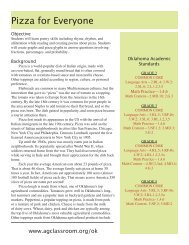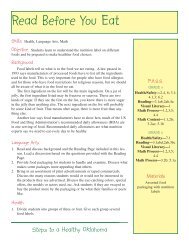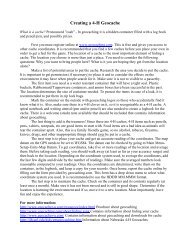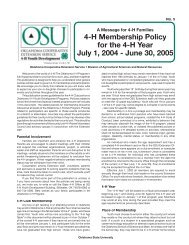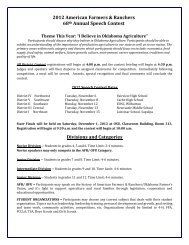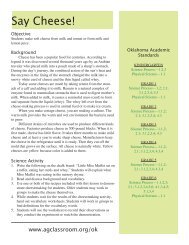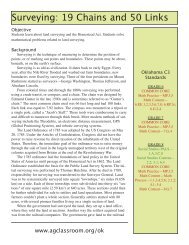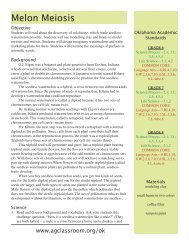You also want an ePaper? Increase the reach of your titles
YUMPU automatically turns print PDFs into web optimized ePapers that Google loves.
<strong>Build</strong> a <strong>Burger</strong><br />
Objective<br />
Students will complete a worksheet by matching clues with the products<br />
used in making hamburgers and match burger parts to picture<br />
parts. Students will conduct a taste test on different kinds of burgers,<br />
compile data and graph the results.<br />
Background<br />
Which food group does a hamburger belong to? Depending on<br />
what you like on your burger, it could have something from every<br />
food group. What do you like on your hamburger? What food group<br />
does it come from? most hamburgers consist of ground beef and<br />
some kind of bread. Ground beef can be made from just about any<br />
part of the beef animal. The next time you go shopping with your<br />
mother or father, pay attention to the different kinds of ground beef at<br />
the meat counter.<br />
Ground beef is high in protein, containing 18 amino acids. eight<br />
of those are essential for human life. niacin, Vitamin B12, thiamin<br />
and zinc are other vitamins and minerals provided by a beef patty.<br />
You can make your hamburger even more nutritious by choosing different<br />
breads and condiments. Whole wheat buns have more fiber and<br />
nutrients than buns made from white flour. raw spinach or leafy lettuce,<br />
onions and tomatoes sprovide nutrients also.<br />
Language arts<br />
1. read and discuss background and vocabulary.<br />
2. Hand out student worksheet A.<br />
—Students will match the clues with the products used in making<br />
hamburgers.<br />
3. Hand out student worksheet B.<br />
—Students will match the burger parts to the picture parts.<br />
Math<br />
1. Conduct a taste test on samples of the products that make up a<br />
hamburger.<br />
—Set up centers and have another class come in and taste the<br />
products.<br />
—Instruct students to wash hands and prepare samples.<br />
—Have three types of buns available (whole wheat, white,<br />
sesame seed), three kinds of cheese (American, Swiss, Cheddar),<br />
etc.<br />
—Visiting students will rate products according to which they like<br />
www.agclassroom.org/ok<br />
Standard<br />
Grade 1<br />
P.A.S.S.<br />
Health—3.1; 6.2,3<br />
Common Core<br />
Language Arts—1.SL.1,2,3; 1.rI.1<br />
Grade 2<br />
P.A.S.S.<br />
math Process—5.1a<br />
math Content—5.1ab<br />
Health—3.1; 6.2,3<br />
Common Core<br />
Language Arts—2.L.4,5; 2.SL.1,2,3<br />
Grade 3<br />
P.A.S.S.<br />
math Process—5.1a<br />
math Content—5.1ab,2<br />
Health—3.1; 6.2,3<br />
Common Core<br />
Language Arts—3.rI.5,7; 3.L.3;<br />
3.SL.2,3<br />
Grade 4<br />
P.A.S.S.<br />
math Process—5.1a<br />
math Content—5.1ab,3<br />
Health—3.1; 6.2,3<br />
Common Core<br />
Language Arts—4.rI.1<br />
Materials<br />
ground beef<br />
hamburger buns—whole wheat,<br />
sesame seed and white<br />
American, Swiss and Cheddar cheese<br />
2-3 different varieties of leaf lettuce,<br />
raw spinach, alfalfa sprouts<br />
tomatoes, onions, pickles<br />
mustard, mayonnaise, catsup
est, second best, and least.<br />
—Students will compile the data and graph the results.<br />
2. Bring in a calorie guide.<br />
—Students will list all the things they like on their hamburgers.<br />
—Students will look up the hamburger parts and add them up to determine<br />
the total calorie count of each of their burgers.<br />
Vocabulary<br />
beef— the flesh of a steer,<br />
cow, or bull<br />
bun—a sweet or plain<br />
small bread<br />
catsup—a thick seasoned<br />
sauce usually made from<br />
tomatoes (also spelled<br />
ketchup)<br />
cheese—a food made from<br />
milk usually by separating<br />
out the curd and molding it<br />
hamburger—a sandwich<br />
consisting of a patty of<br />
hamburger in a split round<br />
lettuce—a common garden<br />
vegetable related to<br />
the daisies that has crisp<br />
juicy leaves used especially<br />
in salads<br />
mustard—a yellow sharptasting<br />
powder of the seeds<br />
of a common mustard used<br />
in food seasonings or in<br />
medicine<br />
onion—a widely grown<br />
Asian herb related to the<br />
lilies and having edible<br />
bulbs that have a sharp<br />
odor and taste and are used<br />
as a vegetable and to season<br />
foods<br />
pickle—an article of food<br />
(as a cucumber) preserved<br />
in a saltwater or vinegar<br />
solution<br />
Health<br />
1. Hand out student worksheet C.<br />
—Discuss the nutrition information on the worksheet.<br />
—Students will draw pictures of their ideal burger.<br />
—Students will draw lines from the nutritional elements to the parts of<br />
the burger.<br />
extra reading<br />
Durant, Alan, and mei matsuoka, <strong>Burger</strong> Boy, Clarion, 2006.<br />
reiss, mike, and Xeth Feinberg, City of Hamburgers, Inkwater, 2003.<br />
Showers, Paul, and edward miller, What Happens to a Hamburger?, Collins,<br />
2001.<br />
Smith, Alexander mcCall Smith, The Perfect Hamburger and Other<br />
Delicious Stories, Bloomsbury USA Childrens, 2007.<br />
Wong, Herbert Yee, Hamburger Heaven, Sandpiper, 2005.<br />
Hamburger Tasting Party: Super Student Sliders<br />
(mini-healthburgers)<br />
Ask parents to help provide a variety of ingredients so students can build<br />
healthburgers. Start with these basic ingredients:<br />
3 lbs. lean ground beef<br />
seasoned salt<br />
24 whole wheat rolls<br />
4 tomatoes<br />
12 slices cheese, halved<br />
sliced dill pickles<br />
leafy lettuce<br />
catsup, mustard, mayonnaise<br />
Additional healthy ingredients: leaf spinach, avocado, alfalfa sprouts, etc.<br />
1. mix seasoned salt into ground beef.<br />
2. Form 24 small patties.<br />
3. Use an electric skillet to fry hamburger patties.<br />
4. Students build their own burgers, keeping health in mind.<br />
5. Invite a school nurse or nutritionist to act as judge, and give a prize for<br />
the healthiest burger.<br />
www.agclassroom.org/ok
name______________________________________________________________________________<br />
<strong>Build</strong> a <strong>Burger</strong><br />
a<br />
Read the recipes on the recipe cards. Cut out the burger parts pictured below and match them to the correct<br />
recipe. Paste the burger parts in the boxes.<br />
1. mill wheat into flour. mix<br />
the flour with yeast, water and<br />
other ingredients. Bake the<br />
dough in an oven. Put it in a<br />
package and place it on a shelf<br />
at the grocery store to sell.<br />
2. Add a culture to milk to<br />
separate it into curds and<br />
whey. Pour off the whey and<br />
press the curds together. Add<br />
flavorings or spices, if desired.<br />
Age the solid block to allow<br />
the flavor to develop.<br />
4. Crush soybeans to remove<br />
their oil. Carefully mix the<br />
soybean oil with eggs, spices<br />
and other ingredients to make<br />
a white topping you can<br />
spread with a knife. Seal it in<br />
jars and send it to the supermarket.<br />
3. Cook tomatoes into a<br />
sauce. Add spice and<br />
flavorings. Pour it into a<br />
bottle and send it to the<br />
supermarket.<br />
oklahoma Ag in the Classroom is a program of the oklahoma Cooperative extension Service, oklahoma<br />
Department of Agriculture, Food and Forestry and the oklahoma State Department of education.
name______________________________________________________________________________<br />
<strong>Build</strong> a <strong>Burger</strong><br />
B<br />
A cheeseburger usually has products from all the food groups. Can you identify the parts of this cheeseburger?<br />
In the left blank write the name of the cheeseburger part. In the right blank, list the food group to which<br />
it belongs. Then color your cheeseburger.<br />
bun<br />
bread, cereal, rice, pasta<br />
Word Bank<br />
onion<br />
cheese<br />
bun<br />
lettuce<br />
mustard<br />
pickle<br />
ground beef<br />
Food Groups<br />
• Fats, oils, sweets<br />
• milk, yogurt, cheese<br />
• meat, poultry, fish, dry<br />
beans, eggs and nuts<br />
• Vegetables<br />
• Fruit<br />
• Bread, cereal, rice, pasta<br />
oklahoma Ag in the Classroom is a program of the oklahoma Cooperative extension Service, oklahoma<br />
Department of Agriculture, Food and Forestry and the oklahoma State Department of education.
name______________________________________________________________________________<br />
<strong>Build</strong> a <strong>Burger</strong><br />
nutrition Provided by a Hamburger<br />
C<br />
WHoLe WHeAT BreAD provides B vitamins, fiber and antioxidants.<br />
TomAToeS are a rich source of several nutrients. They are well known for their high Vitamin C content but<br />
also contain significant amounts of Vitamin A. B vitamins including niacin and riboflavin, magnesium, phosphorous<br />
and calcium. Tomatoes are also a good source of chromium and folate.<br />
BeeF is found to be very rich in Zinc, Selenium, Phosphorus, Potassium and magnesium. Sodium and Copper<br />
are found in good quantities. Beef is one of the best source for Vitamin B12, Vitamin B6 niacin and<br />
riboflavin. It is also a great source of protein for your body. It is also rich in Thiamin and Pantothenic Acid.<br />
Small amounts of Vitamin e, Vitamin K and Folate are present.<br />
CHeeSe is a dairy product. It provides your body with Vitamin D and calcium.<br />
other items on the hamburger such as pickles, mustard, mayonnaise, catsup, etc. provide flavor and sodium.<br />
In the space below draw a picture of a healthy hamburger. make sure to include all the items listed above:<br />
Draw a red line<br />
to the part that<br />
gives you protein.<br />
Draw an<br />
orange line to<br />
the part that<br />
gives you calcium.<br />
Draw a blue<br />
line to the part<br />
that provides<br />
fiber.<br />
Draw a green<br />
line to the item<br />
that provides<br />
Vitamin C.<br />
oklahoma Ag in the Classroom is a program of the oklahoma Cooperative extension Service, oklahoma<br />
Department of Agriculture, Food and Forestry and the oklahoma State Department of education.



